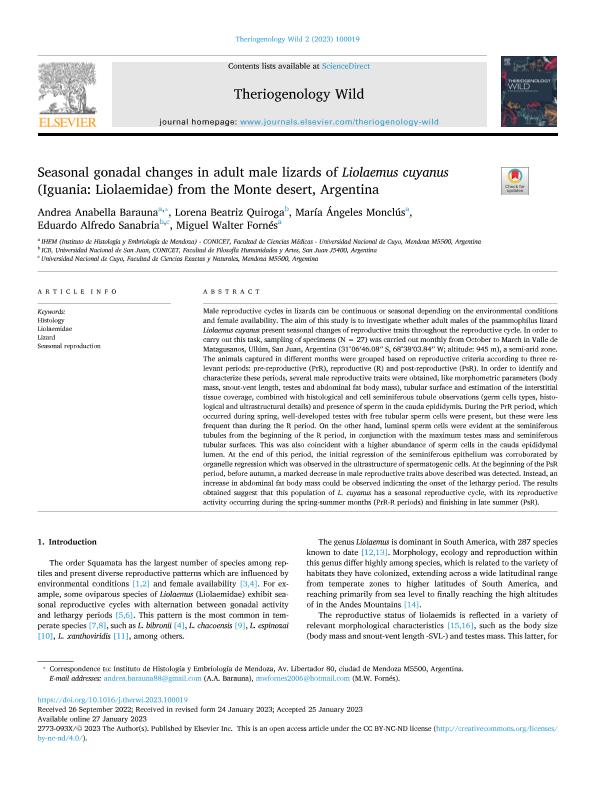Mostrar el registro sencillo del ítem
dc.contributor.author
Barauna, Andrea Anabella

dc.contributor.author
Quiroga, Lorena Beatriz

dc.contributor.author
Monclus, Maria de Los Angeles

dc.contributor.author
Sanabria, Eduardo Alfredo

dc.contributor.author
Fornes, Miguel Walter

dc.date.available
2024-01-30T16:05:00Z
dc.date.issued
2023-01
dc.identifier.citation
Barauna, Andrea Anabella; Quiroga, Lorena Beatriz; Monclus, Maria de Los Angeles; Sanabria, Eduardo Alfredo; Fornes, Miguel Walter; Seasonal gonadal changes in adult male lizards of Liolaemus cuyanus (Iguania: Liolaemidae) from the Monte desert, Argentina; Elsevier; Theriogenology Wild; 2; 100019; 1-2023; 1-10
dc.identifier.issn
2773-093X
dc.identifier.uri
http://hdl.handle.net/11336/225288
dc.description.abstract
Male reproductive cycles in lizards can be continuous or seasonal depending on the environmental conditions and female availability. The aim of this study is to investigate whether adult males of the psammophilus lizard Liolaemus cuyanus present seasonal changes of reproductive traits throughout the reproductive cycle. In order to carry out this task, sampling of specimens (N = 27) was carried out monthly from October to March in Valle de Matagusanos, Ullúm, San Juan, Argentina (31°06?46.08?? S, 68°38?03.84?? W; altitude: 945 m), a semi-arid zone. The animals captured in different months were grouped based on reproductive criteria according to three relevant periods:pre-reproductive (PrR), reproductive (R) and post-reproductive (PsR). In order to identify and characterize these periods, several male reproductive traits were obtained, like morphometric parameters (body mass, snout-vent length, testes and abdominal fat body mass), tubular surface and estimation of the interstitial tissue coverage, combined with histological and cell seminiferous tubule observations (germ cells types, histological and ultrastructural details) and presence of sperm in the cauda epididymis. During the PrR period, which occurred during spring, well-developed testes with free tubular sperm cells were present, but these were less frequent than during the R period. On the other hand, luminal sperm cells were evident at the seminiferous tubules fromthe beginning of the R period, in conjunction with the maximum testes mass and seminiferous tubular surfaces. This was also coincident with a higher abundance of sperm cells in the cauda epididymal lumen. At the end of this period, the initial regression of the seminiferous epithelium was corroborated by organelle regression which was observed in the ultrastructure of spermatogenic cells. At the beginning of the PsR period, before autumn, a marked decrease in male reproductive traits above described was detected. Instead, an increase in abdominal fat body mass could be observed indicating the onset of the lethargy period. The results obtained suggest thatthis population of L. cuyanus has a seasonal reproductive cycle, with its reproductive activity occurring during the spring-summer months (PrR-R periods) and finishing in late summer (PsR).
dc.format
application/pdf
dc.language.iso
eng
dc.publisher
Elsevier

dc.rights
info:eu-repo/semantics/openAccess
dc.rights.uri
https://creativecommons.org/licenses/by-nc-nd/2.5/ar/
dc.subject
MALR REPRODUCTION
dc.subject
LIZARD
dc.subject
MONTE DESERT
dc.subject
HISTOLOGY
dc.subject.classification
Zoología, Ornitología, Entomología, Etología

dc.subject.classification
Ciencias Biológicas

dc.subject.classification
CIENCIAS NATURALES Y EXACTAS

dc.title
Seasonal gonadal changes in adult male lizards of Liolaemus cuyanus (Iguania: Liolaemidae) from the Monte desert, Argentina
dc.type
info:eu-repo/semantics/article
dc.type
info:ar-repo/semantics/artículo
dc.type
info:eu-repo/semantics/publishedVersion
dc.date.updated
2024-01-29T15:28:27Z
dc.journal.volume
2
dc.journal.number
100019
dc.journal.pagination
1-10
dc.journal.pais
Países Bajos

dc.journal.ciudad
Amsterdam
dc.description.fil
Fil: Barauna, Andrea Anabella. Consejo Nacional de Investigaciones Científicas y Técnicas. Centro Científico Tecnológico Conicet - Mendoza. Instituto de Histología y Embriología de Mendoza Dr. Mario H. Burgos. Universidad Nacional de Cuyo. Facultad de Ciencias Médicas. Instituto de Histología y Embriología de Mendoza Dr. Mario H. Burgos; Argentina
dc.description.fil
Fil: Quiroga, Lorena Beatriz. Universidad Nacional de San Juan. Facultad de Filosofía, Humanidades y Artes. Instituto de Ciencias Básicas; Argentina. Consejo Nacional de Investigaciones Científicas y Técnicas. Centro Científico Tecnológico Conicet - San Juan; Argentina
dc.description.fil
Fil: Monclus, Maria de Los Angeles. Consejo Nacional de Investigaciones Científicas y Técnicas. Centro Científico Tecnológico Conicet - Mendoza. Instituto de Histología y Embriología de Mendoza Dr. Mario H. Burgos. Universidad Nacional de Cuyo. Facultad de Ciencias Médicas. Instituto de Histología y Embriología de Mendoza Dr. Mario H. Burgos; Argentina
dc.description.fil
Fil: Sanabria, Eduardo Alfredo. Consejo Nacional de Investigaciones Científicas y Técnicas. Centro Científico Tecnológico Conicet - San Juan; Argentina. Universidad Nacional de San Juan. Facultad de Filosofía, Humanidades y Artes. Instituto de Ciencias Básicas; Argentina. Universidad Nacional de Cuyo. Facultad de Ciencias Exactas y Naturales; Argentina
dc.description.fil
Fil: Fornes, Miguel Walter. Consejo Nacional de Investigaciones Científicas y Técnicas. Centro Científico Tecnológico Conicet - Mendoza. Instituto de Histología y Embriología de Mendoza Dr. Mario H. Burgos. Universidad Nacional de Cuyo. Facultad de Ciencias Médicas. Instituto de Histología y Embriología de Mendoza Dr. Mario H. Burgos; Argentina
dc.journal.title
Theriogenology Wild
dc.relation.alternativeid
info:eu-repo/semantics/altIdentifier/url/https://www.sciencedirect.com/science/article/pii/S2773093X2300003X
dc.relation.alternativeid
info:eu-repo/semantics/altIdentifier/doi/https://doi.org/10.1016/j.therwi.2023.100019
Archivos asociados
